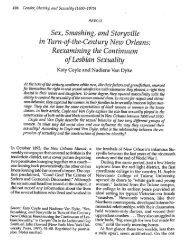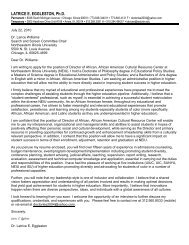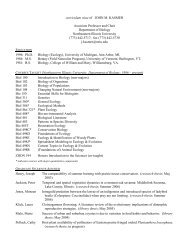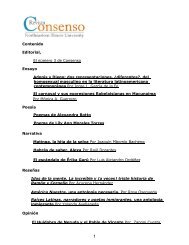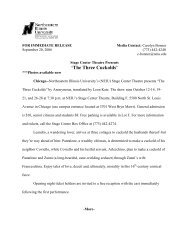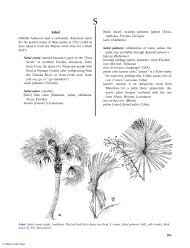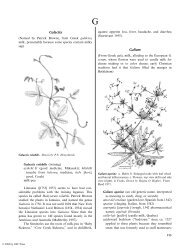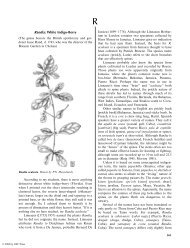Herba Cana - Northeastern Illinois University
Herba Cana - Northeastern Illinois University
Herba Cana - Northeastern Illinois University
Create successful ePaper yourself
Turn your PDF publications into a flip-book with our unique Google optimized e-Paper software.
© 2004 by CRC Press<br />
The Ethnobotany 501<br />
Netherlands. Not long afterward, in 1751, Linnaeus<br />
coined the generic name Phryma and left everyone<br />
wondering on what he based the name. Species<br />
Plantarum (Linnaeus [1753] 1957) states simply,<br />
‘‘Habitat in America septentrionalis’’ (Grows in North<br />
America).<br />
That problematic etymology of the generic name<br />
set the stage for trying to understand the relationships<br />
of these plants. They have been put in their own<br />
family, the Phrymaceae, or the Verbenaceae. The most<br />
recent molecular genetic studies support Phryma being<br />
removed from the other families and recognized as a<br />
distinct lineage (Wagstaff and Olmstead 1997).<br />
Although Linnaeus did not know it when he<br />
named the herbs, the genus is disjunct between Asia<br />
and North America. There has been a tendency to call<br />
the Old World plants a different species from the<br />
American, but the differences are minor (Hara 1969).<br />
Since the late 1960s, most have considered them a<br />
single, bicentric species in the monotypic Phryma.<br />
In North America, the plants are considered native<br />
from New Brunswick to Manitoba, south to Florida,<br />
Alabama, Louisiana, and eastern Texas (Fernald 1950,<br />
Steyermark 1963, Barkley 1986, Jones and Coile 1988,<br />
Diggs et al. 1999). These plants are widespread and<br />
important medicines in Asia, but few records exist of<br />
their application in the Americas. The Ojibwa chewed<br />
roots or gargled a root decoction to relieve sore throat,<br />
and drank the decoction when they had rheumatism<br />
(Densmore 1928, Moerman 1998).<br />
Hocking (1997) noted that the leaves and roots are<br />
insecticidal and have been used to kill houseflies in<br />
Japan and China. Elsewhere in Asia, the plants are<br />
used to treat fevers, ulcers, ringworms, scabies, boils,<br />
carbuncles, and cancers (Hsu 1986, Foster and Duke<br />
1990). The herbs contain phryumarol, a sterol (Hocking<br />
1997).<br />
Phyla<br />
(João de Louriero, 1717 /1791, used Greek phyle, a<br />
tribe or clan, an allusion to the many flowers in tight<br />
heads)<br />
fog fruit (in use for P. nodiflora in the Americas by<br />
1886; the old meaning of ‘‘fog’’ was for ‘‘grasses’’<br />
that sprang up in fields immediately after the hay<br />
was harvested; that sense dates from the 14th<br />
century A.D.; the concept of moisture in the air<br />
did not appear until the 1500s, although it now<br />
precludes the older use); frog fruit (corruption of<br />
‘‘fog fruit’’)<br />
Phyla lanceolata. Drawn by Vivian Frazier. From Correll and<br />
Correll 1972.<br />
Phyla lanceolata<br />
lance-leaf fog-fruit<br />
Phyla stoechadifolia (leaves resembling those of<br />
the mint Lavandula stoechas) ( /Lippia stochadifolia)<br />
azulejo (little blue one)<br />
epazotillo (little epazote, Chenopodium ambrosioides,<br />
Totonac, Veracruz)<br />
guia huace [quie huace] (guia, flower, huace, smell<br />
of roses or sweet fruit, Zapotec, Oaxaca)<br />
kabalyaxmik [cabalyaxnic] (kabal, small plant,<br />
ya’ax, green, nik, joined to, in other words, small<br />
plant that grows with the ya’ax che’, Ceiba<br />
pentandra, the green tree that supports the world;<br />
Maya, Yucatán)<br />
marsh phyla (a book name)<br />
orozús (literally, ‘‘juicy-root,’’ a name usually given<br />
to a legume, Belize)<br />
poleo [poley] (a mint resembling ‘‘yerbabuena’’ or<br />
Mentha, Puerto Rico)<br />
southern fog-fruit (Florida)





